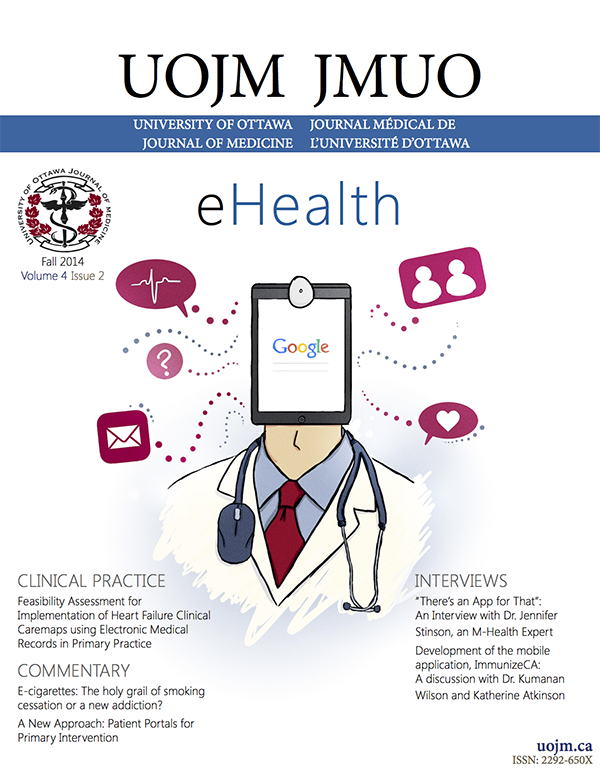Endovascular Stenting for Idiopathic Intracranial Hypertension
DOI:
https://doi.org/10.18192/uojm.v4i2.1045Keywords:
idiopathic intracranial hypertension (IIH), transverse sinus stenosis (TSS), endovascular, stent, intracranial pressure (ICP), headache, papilledema, cerebrospinal fluid (CSF), Starling-like Resistor, neuroradiologyAbstract
Transverse sinus stenosis (TSS) is often observed in patients with idiopathic intracranial hypertension (IIH). Studies show that all symptoms of IIH can be resolved by transverse sinus stent placement. We present a case of a 39-year-old woman diagnosed with IIH presented with papilledema and severe headaches. The consideration of interventional management was necessitated by the preceding failure of several months of medical treatment. Her vascular imaging demonstrated stenosis of the transverse sinus and her intracranial venous pressure measurements indicated elevated pressure with a high pressure gradient across the stenosis. She underwent transverse sinus stent placement across the stenotic segment. After this intervention, her symptoms improved and her intracranial pressure normalized. The imaging follow-up revealed efficacious patency of the stent. Based on a mathematical model, we suggest that a Starling-like resistor demonstrating a collapsible transverse sinus can permanently be replaced by a rigid-walled sinus upon employment of an endovascular stent in the stenotic transverse sinus, which should be considered as an alternative to other surgical procedures for IIH patients.References
1. Friedman DI, Jacobson DM. Idiopathic intracranial hypertension. J Neurophthalmol 2004;24:138–45.
2. Daniels AB, Liu GT, Volpe NJ, et al. Profiles of obesity, weight gain, and quality of life in idiopathic intracranial hypertension (pseudotumor cerebri). Am J Ophthalmol 2007;143:635–41
3. De Simone R, Ranieri A. Advancement in idiopathic intracranial hypertension pathogenesis: focus on sinus venous stenosis. Neurol Sci 2010;31:S33–39
4. Shah VA, Kardon RH, Lee AG, et al. Long-term follow-up of idiopathic intracranial hypertension: the Iowa experience. Neurology 2008;70(8):634-40.
5. Liu GT, Volpe NJ, Schatz NJ, et al. Severe sudden visual loss caused by pseudotumor cerebri and lumboperitoneal shunt failure. Am J Ophthalmol 1996;122(1):129-31.
6. Fishman RA. The pathophysiology of pseudotumor cerebri. Arch Neurol 1984;41:257-258.
7. Donaldson JO. Pathogenesis of pseudotumor cerebri syndromes. Neurology 1981;31:877-80.
8. Brazis PW. Clinical review: the surgical treatment of idiopathic pseudotumour cerebri (idiopathic intracranial hypertension). Cephalgia 2008;28:1361-73.
9. Wang VY, Barbaro NM, Lawton MT, et al. Complications of lumboperitoneal shunts. Neurosurgery 2007;60:1045-48
10. Owler B. CSF shunt failure: an ongoing epidemic? J Neurol Neurosurg Psychiatry 2009;80:1185
11. King JO, Mitchell PJ, Thomson KR, et al. Cerebral venography and manometry in idiopathic intracranial hypertension. Neurology 1995;45:2224–28
12. Ogungbo B, Roy D, Gholkar A, et al. Endovascular stenting of the transverse sinus in a patient presenting with benign intracranial hypertension. Br J Neurosurg 2003;17:565–68
13. Bussiere M, Falero R, Nicolle D, et al. Unilateral transverse sinus stenting of patients with idiopathic intracranial hypertension. AJNR Am J Neuroradiol 2010;31:645–50
14. Ahmed R, Wilkinson M, Parker G, et al. AJNR Am J Neuroradiol 2011;32:1408 –14
15. Higgins JN, Pickard JD. Lateral sinus stenosis in idiopathic intracranial hypertension resolving after CSF diversion. Neurology 2004;62:1907–08.
16. Roche J, Warner D. Arachnoid granulations in the transverse and sigmoid sinuses: CT, MR and MR angiographic appearance of a normal anatomic variation. AJNR Am J Neuroradiol 1996;17:677–83.
17. Stevens SA, Previte M. Idiopathic intracranial hypertension and transverse sinus stenosis: a modelling study. Math Med Biol 2007;24(1):85-109.
2. Daniels AB, Liu GT, Volpe NJ, et al. Profiles of obesity, weight gain, and quality of life in idiopathic intracranial hypertension (pseudotumor cerebri). Am J Ophthalmol 2007;143:635–41
3. De Simone R, Ranieri A. Advancement in idiopathic intracranial hypertension pathogenesis: focus on sinus venous stenosis. Neurol Sci 2010;31:S33–39
4. Shah VA, Kardon RH, Lee AG, et al. Long-term follow-up of idiopathic intracranial hypertension: the Iowa experience. Neurology 2008;70(8):634-40.
5. Liu GT, Volpe NJ, Schatz NJ, et al. Severe sudden visual loss caused by pseudotumor cerebri and lumboperitoneal shunt failure. Am J Ophthalmol 1996;122(1):129-31.
6. Fishman RA. The pathophysiology of pseudotumor cerebri. Arch Neurol 1984;41:257-258.
7. Donaldson JO. Pathogenesis of pseudotumor cerebri syndromes. Neurology 1981;31:877-80.
8. Brazis PW. Clinical review: the surgical treatment of idiopathic pseudotumour cerebri (idiopathic intracranial hypertension). Cephalgia 2008;28:1361-73.
9. Wang VY, Barbaro NM, Lawton MT, et al. Complications of lumboperitoneal shunts. Neurosurgery 2007;60:1045-48
10. Owler B. CSF shunt failure: an ongoing epidemic? J Neurol Neurosurg Psychiatry 2009;80:1185
11. King JO, Mitchell PJ, Thomson KR, et al. Cerebral venography and manometry in idiopathic intracranial hypertension. Neurology 1995;45:2224–28
12. Ogungbo B, Roy D, Gholkar A, et al. Endovascular stenting of the transverse sinus in a patient presenting with benign intracranial hypertension. Br J Neurosurg 2003;17:565–68
13. Bussiere M, Falero R, Nicolle D, et al. Unilateral transverse sinus stenting of patients with idiopathic intracranial hypertension. AJNR Am J Neuroradiol 2010;31:645–50
14. Ahmed R, Wilkinson M, Parker G, et al. AJNR Am J Neuroradiol 2011;32:1408 –14
15. Higgins JN, Pickard JD. Lateral sinus stenosis in idiopathic intracranial hypertension resolving after CSF diversion. Neurology 2004;62:1907–08.
16. Roche J, Warner D. Arachnoid granulations in the transverse and sigmoid sinuses: CT, MR and MR angiographic appearance of a normal anatomic variation. AJNR Am J Neuroradiol 1996;17:677–83.
17. Stevens SA, Previte M. Idiopathic intracranial hypertension and transverse sinus stenosis: a modelling study. Math Med Biol 2007;24(1):85-109.
Downloads
Published
2014-11-17
Issue
Section
Case Report & Elective report
License
- Authors publishing in the UOJM retain copyright of their articles, including all the drafts and the final published version in the journal.
- While UOJM does not retain any rights to the articles submitted, by agreeing to publish in UOJM, authors are granting the journal right of first publication and distribution rights of their articles.
- Authors are free to submit their works to other publications, including journals, institutional repositories or books, with an acknowledgment of its initial publication in UOJM.
- Copies of UOJM are distributed both in print and online, and all materials will be publicly available online. The journal holds no legal responsibility as to how these materials will be used by the public.
- Please ensure that all authors, co-authors and investigators have read and agree to these terms.
- Works are licensed under a Creative Commons Attribution-NonCommercial-NoDerivatives 4.0 International License.


